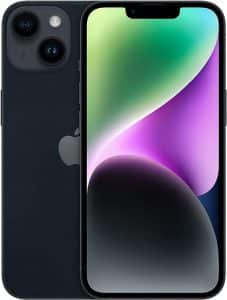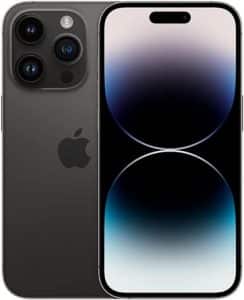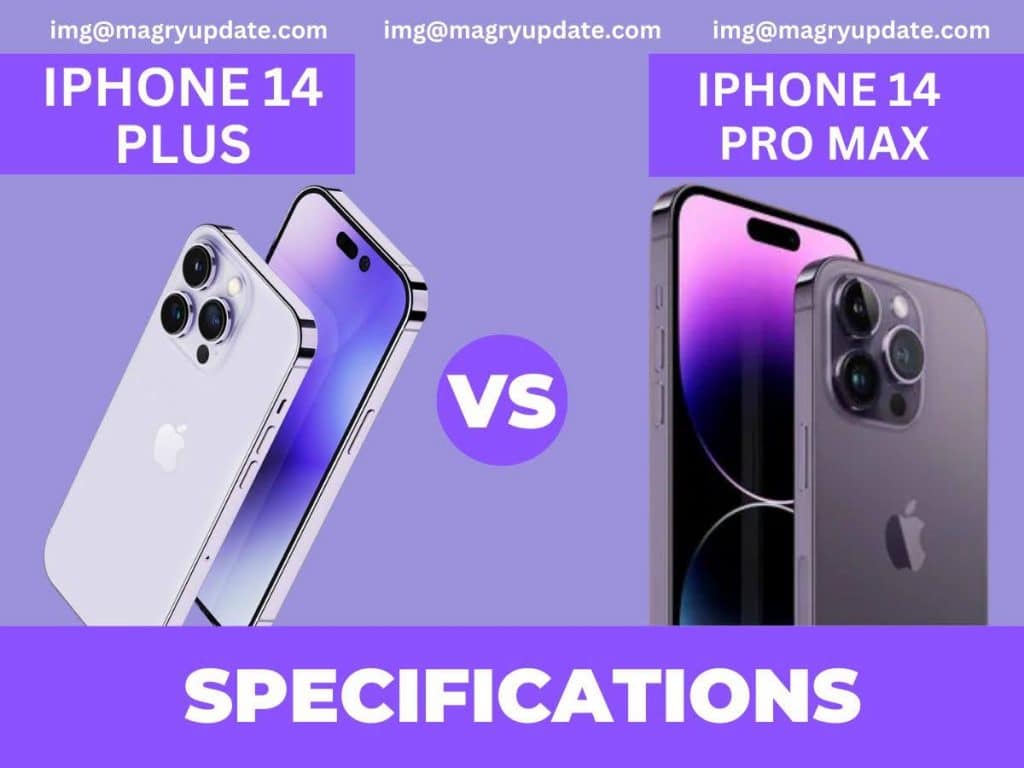Early in September 2022, Apple unveiled the iPhone 14 series, which includes four models: the iPhone 14, iPhone 14 Plus, iPhone 14 Pro, and iPhone 14 Pro Max. This comparison of the iPhone 14 vs. 14 Pro demonstrates how much broader the gap has become between Apple’s two primary iPhone line-ups this year.
Instead of being just an improved version of the iPhone 14, like previous iPhone Pro models were, the iPhone 14 Pro seems like a whole new device. However, practically everything this time around has changed, including the design, chipset, and others.
Though they both have screens the same size, the iPhone 14 seems like a reasonably little advance over the iPhone 13, while the iPhone 14 Pro offers far more significant upgrades over the iPhone 13 Pro.
In this comparison of the iPhone 14 vs. 14 Pro, we’ll highlight their main differences so you can choose the right model. It’s critical to consider what distinguishes these phones, which share a number and a little more.
We will also highlight and compare the iPhone 14 vs. 14 Pro, iPhone 14 Pro vs. Pro Max, and iPhone 14 Plus vs. Pro Max.
iPhone 14 Vs. 14 Pro: Design and Display
The first difference between the iPhone 14 and iPhone 14 Pro is in this area. The diagonal camera lens arrangement and narrower notch on the regular iPhone 14 are essentially the same as those on the iPhone 13 from the previous year.
But it turns out Apple devoted its efforts to the iPhone 14 Pro. From the back, the design resembles that of the iPhone 13 Pro, although the camera module is bigger because of the new 48MP primary sensor. This year’s “fun Pro color” is a stunning deep purple, a rich violet suitable for royalty. Meanwhile, the new canary yellow color is reserved only for the iPhone 14 and 14 Plus.
The iPhone 14 Pro no longer has a notch across the front, and its place has been taken by a large pill-shaped cutout that serves as the centerpiece of what Apple calls the Dynamic Island. With the help of this function, the cutout for alerts and related notifications is expanded to fit the additional screen space better.
The notch, which had been present since the release of the iPhone X in 2017, was therefore eliminated by the iPhone 14 Pro. The iPhone 14 Pro may appeal to you much if you’re sick of the same old iPhone design.
The good news is that the whole array of iPhone 14 models only comes in two screen sizes this year: 6.1 inches and 6.7 inches. The smallest iPhone models are the 14 and 14 Pro, whereas the 14 Plus and 14 Max have extremely big screens.
What Do They Have In Common?
All four use OLEDs as the panel technology and have Apple’s Super Retina XDR display. The iPhone 14 and iPhone 14 Pro both have a resolution of 2532 x 1170 (460 ppi), making them both functionally equivalent.
The iPhone 14 Plus has a resolution of 2778 x 1284 (458 ppi), while the iPhone 14 Pro Max has a resolution of 2796 x 1290 (460 ppi).
In terms of brightness, Apple highlights both the Pro and basic versions as having extremely bright screens.
While the iPhone 14 Pro is expected to have a mind-blowing peak HDR brightness of 2,000 nits, the iPhone 14 only has a maximum HDR brightness of 1,200 nits. That is twice as bright as the iPhone 13 Pro’s rating, making it the brightest smartphone display we’ve ever seen.
In contrast, the iPhone 14 Pro achieved a maximum HDR brightness of 1,448 nits during our tests. At 734 nits, the iPhone 14 performed significantly worse.
The iPhone 14 Pro is the first model to include an always-on display. When your phone’s screen is off, you may glimpse some essential information thanks to its low-power mode.
As Apple mainly relies on the adaptive refresh rate of the iPhone 14 Pro to prevent an always-on display from depleting the phone’s battery, the iPhone 14 does not enjoy this functionality, which is standard on practically every Android phone.
The displays on iPhones are stunning, as they always are. The iPhone 14 and iPhone 14 Pro are impressive with any visual material thanks to their vibrant colors and deep blacks. However, the Pro has a clear edge in brightness, making it perfect for outdoor use.
iPhone 14 Vs. 14 Pro: Camera
Both the Apple iPhone 14 and iPhone 14 Plus have two rear cameras. You benefit from a secondary ultra-wide camera and the primary 12MP wide camera.
These resolutions are identical to those of the iPhone 13. However, the primary camera has been updated to match those of the iPhone 13 Pro, resulting in a slightly wider aperture of f/1.5 instead of f/1.6.
Meanwhile, there was a significant update to the iPhone 14 Pro and iPhone 14 Pro Max. A 48MP primary sensor, a 12-megapixel ultra-wide sensor with a larger aperture, and 12-megapixel telephoto sensors are also included.
The telephoto lens and 15x digital zoom on the iPhone 14 Pro versions provide 3x optical zoom. Standard iPhone 14 versions lack optical zoom but feature a 5x digital zoom. The Pro versions also have ProRES, which enables you to take raw 48-megapixel photos.
The characteristics of Portrait Mode with Depth Control, Night Mode, Photographic Styles, and Cinematic Mode are shared by all four models.
All four iPhone 14 versions are equipped with an Action Mode feature and a Photonic Engine, which is touted to enhance low-light photography. While the Pro versions are better, the regular models still produce excellent point-and-shoot photographs.
All four models include updated front cameras with 12-megapixel resolution, a larger f/1.9 aperture, and autofocus for the inaugural time. These features are quite useful for selfies and video calls.
iPhone 14 Vs. 14 Pro: Performance and Battery Life
The chipset is another distinction between the iPhone 14 and iPhone 14 Pro. The A15 Bionic from the previous year remains in the iPhone 14. However, it is the more powerful model seen in the iPhone 13 Pro, the one with a 5-core GPU.
The new A16 Bionic, equipped with a hexacore CPU, penta-core GPU, and 16-core Neural Engine and manufactured using a 4nm technology, is available for the iPhone 14 Pro. This processor is extremely powerful and outperforms any other smartphone.
Another difference can be seen in the GPU, with the iPhone 14 Pro maintaining an average frame rate of 74 fps in 3DMark Wild Life Unlimited. The same benchmark yielded 69 fps on the iPhone 14.
In the case of the Adobe Premiere Rush, 4K-1080p transcode test, the phones are essentially comparable, with the iPhone 14 Pro finishing the benchmark at 26 seconds and the iPhone 14 following closely behind at 28 seconds.
The difference between the iPhone 14 Pro and iPhone 14 may be noticeable to performance freaks, but most people won’t. However, you should go for Pro if you want the best.
Here is what Apple says regarding battery life for its latest iPhones:
- Up to 20 hours of video may be played on the iPhone 14.
- The iPhone 14 Plus has a video playback time of up to 26 hours.
- Up to 23 hours of video playback on the iPhone 14 Pro.
- Up to 29 hours of video playback on the iPhone 14 Pro Max.
iPhone 14 Vs. 14 Pro: Price and Availability
On September 16, Apple announced the iPhone 14, iPhone 14 Pro, and iPhone 14 Pro Max. The iPhone 14 Plus followed on October 7. The Pro Max is priced at $1,099, followed by the Plus at $899, the Pro at $999, and the 14 at $799 in the range.
Since these are Apple iPhones, you can buy either one almost anywhere.
Comparing all Versions of this phone
| iPhone 14 | iPhone 14 Plus | iPhone 14 Pro | iPhone 14 Pro Max | |
| Size | 6.1 inches | 6.7 inches | 6.1 inches | 6.7 inches |
| Resolution | 2532×1170 pixels | 2778‑by‑128 pixels | 2556‑by‑117 pixels | 2796‑by‑1290 pixels |
| PPI | 460 ppi | 458 ppi | 460 ppi | 460 ppi |
| Typical brightness | 800 nits max | 800 nits max | 1000 nits max | 1000 nits max |
| Outdoor brightness | 800 nits max | 800 nits max | 2000 nits max | 2000 nits max |
| HDR brightness | 1200 nits max | 1200 nits max | 1600 nits max | 1600 nits max |
| Height | 5.78 inches (146mm) | 6.33 inches (160.8mm) | 5.81 inches (147.5mm) | 6.33 inches (160.7mm) |
| Width | 2.82 inches
(71.5mm) |
3.07 inches (78.1mm) | 2.81 inches (71.5mm) | 3.05 inches (77.6mm) |
| Thickness | 0.31 inches (7.80mm) | 0.31 inches
(7.80mm) |
0.31 inches
(7.85mm) |
0.31 inches
(7.85mm) |
| Weight | 6.07 ounces
(172 grams) |
7.16 ounces
(203 grams) |
7.27 ounces
(206 grams) |
8.47 ounces
(240 grams) |
| Durability | IP68 (splash, dust, and up to 6 meters of water for 30 minutes) | IP68 (splash, dust, and up to 6 meters of water for 30 minutes) | IP68 (splash, dust, and up to 6 meters of water for 30 minutes) | IP68 (splash, dust, and up to 6 meters of water for 30 minutes) |
| Back material | Glossy glass | Glossy glass | Matte glass | Matte glass |
| Edges | Aluminium | Aluminium | Stainless steel | Stainless steel |
| Processor | A15 Bionic | A15 Bionic | A16 Bionic | A16 Bionic |
| CPU | 6-core: 2 performance + 4 efficiency | 6-core: 2 performance + 4 efficiency | 6-core: 2 performance + 4 efficiency | 6-core: 2 performance + 4 efficiency |
| GPU | 5-core | 5-core | 5-core | 5-core |
| RAM | 6GB | 6GB | 6GB | 6GB |
| Neural Engine | 16-core | 16-core | 16-core | 16-core |
| Video playback | 20 hours | 26 hours | 23 hours | 29 hours |
| Audio playback | 80 hours | 100 hours | 75 hours | 95 hours |
Brief Summary of iPhone 14, iPhone 14 Pro, iPhone 14 Plus and iPhone 14 Pro Max
-
iPhone 14

The iPhone 14 has a vibrant OLED-based 6.1-inch Super Retina XDR display and an action mode for steady, smooth-playing handheld videos.
Pros
- Excellent display
- Has action mode
- Great design
Cons
- Lacks memory card slot
- No always on display
-
iPhone 14 Pro

The most recent premium phone from Apple is flawless. It is Apple’s greatest phone to date and our top pick for recommendation due to its beautiful and sturdy build, cameras, and display. However, the iPhone 14 Pro Max is the finest if you want something large.
Pros
- Updated design
- Awesome display
- Excellent battery life
Cons
- Costly
- Lacks USB-C
-
iPhone 14 Plus

The iPhone 14 Plus has the same technology and functionality as the iPhone 14 but with a bigger display and battery – all outstanding on this model. This is the one to choose if you want a large display and an excellent battery life at a reasonable price.
Pros
- A huge and striking display
- Excellent design
- Good battery
Cons
- It always lacks on display
- A minor chip update
-
iPhone 14 Pro Max

With a 6.7-inch OLED display and a bigger battery, the iPhone 14 Pro Max offers the same hardware and design as the iPhone 14 Pro. Although pricey, it is incomparably superior. View at Amazon
Pros
- Superior design
- Excellent display
- Outstanding performance
Cons
- Pricey
- Bulky
Recommendation
iPhone 14 Pro
With this round of improvements, the iPhone 14 Pro seems to be the center of attention, from its stunning new appearance to its improved cameras and potent A16 Bionic CPU.
Because of its stunning and robust structure, cameras, and display, it is Apple’s best phone and our most significant recommendation. However, the iPhone 14 Pro Max is the best option if you need something huge.
SEE ALSO: Best iPhone Cleaner App in 2023 (Free)
Conclusion
Apple’s newest and best products are the iPhone 14 and iPhone 14 Pro. However, deciding which iPhone 14 model to buy might be difficult. Even while the iPhone 14 Pro is undoubtedly more powerful and capable, there are other factors to consider, like price, battery life, and total weight.
There are a few distinctions between the regular iPhone 14 models and the iPhone 14 Pro versions in design, materials, processor, storage options, battery life, display features, and camera features.
Additionally, there are some notable parallels, like the flat edges, Face ID, iOS 16 software, front camera improvements, and display sizes. Dynamic Island is the main reason the iPhone 14 Pro models are more distinctive than in prior years.
So, I believe you can now make a choice if you ever encounter an iPhone 14 vs 14 Pro Max battle when buying any of them.

Pingback: iPhone XR Vs. iPhone 11: Which Is Better? -